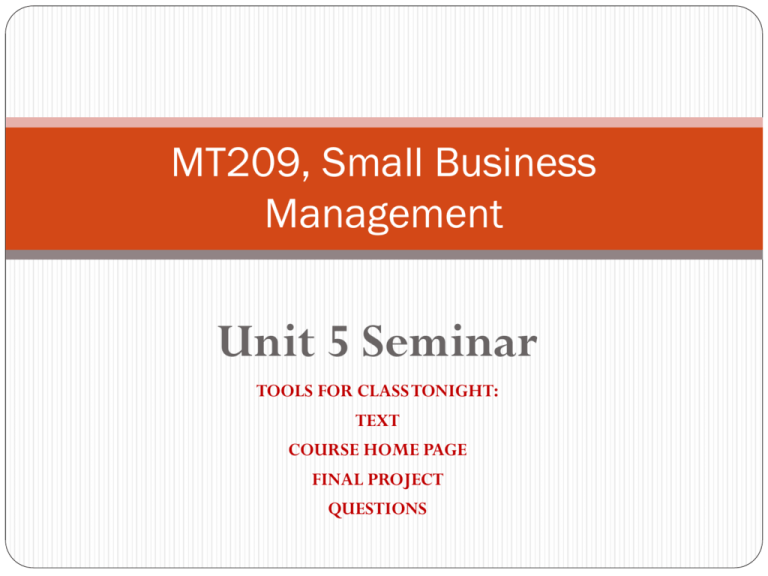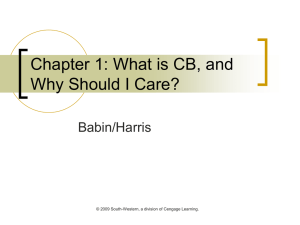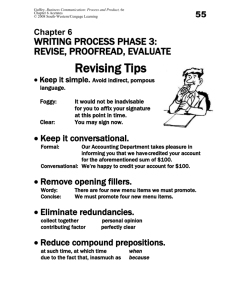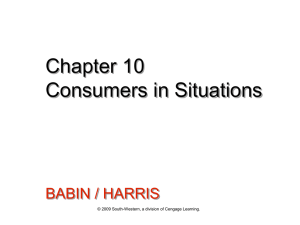
MT209, Small Business
Management
Unit 5 Seminar
TOOLS FOR CLASS TONIGHT:
TEXT
COURSE HOME PAGE
FINAL PROJECT
QUESTIONS
Unit 5 Seminar Game Plan
Course Check-In
Course Website Check-In
Course Activities & Assignments Check-In
Review Unit 3 & 4 Content
Content Review
Assignment Review
Unit 5 Check-In
Look Ahead to the Unit 7 Seminar
Course Check-In
Assignments Review
Reading
Unit 5: The Financial Discussion
Plan & a Firm’s
Final Project –
Sources of Financing Marketing
Assignment: Finance
Seminar
Review
Discussion Posts
Activity –
Spreadsheet
Review – 20
questions
Final Project
Our graded Final Project (Business Plan) is due no
later than the end of Unit 9
To complete our Final Project, please refer to Final
Project Template in Doc Sharing:
In Units 2, 4, 5, 6, & 8, students are encouraged to
work on specific elements of the Final Project
Completed Business Plans should be submitted via
the DropBox (name file: Lastname, firstname,
finalproject)
The Final Project is worth 140 points
Final Project:
Unit 1: Template Home – Start
Unit 2: Executive Summary
Unit 3: Business Description & Vision (Topic Covered in
Units 1 & 2)
Unit 4: Definition of the Market (Covered in Unit 3)
Unit 5: Description of the Products & Services (Covered
in Unit 3)
Unit 6: Organization & Management (Covered in Units 4
& 8)
Unit 7: Marketing & Sales Strategy (Topic Covered in
Units 5, 6, & 7)
Unit 8: Financial Management (Topic Covered in Units 5
& 9)
Unit 9: Generate Business Plan - Submitted in Unit 9
Introduction to Small Business
Our exploration of Small Business Management will focus on
the five (5) parts:
o Entrepreneurship: A World of Opportunity
o Unit 1 (Chapters 1 & 2)
o Starting From Scratch or Joining an Existing Business
o Unit 2 (Chapters 3, 4, & 5)
o Developing the New Venture Business Plan
o Unit 3 (Chapters 6 & 7)
o Unit 4 (Chapters 8 & 9)
o Unit 5 (Chapters 10, 11, & 12)
o Focusing on the Customer: Marketing Growth Strategies
o Unit 6 (Chapters 14 & 15)
o Unit 7 (Chapters 16, 17, & 18)
o Managing Growth in the Small Business
o Unit 8 (Chapters 19 & 20)
o Unit 9 (Chapters 21, 22, & 23)
Exhibit 6.3 Abbreviated Business Plan Outline
Section Heading
• Cover Page
• Table of Contents
• Executive Summary
•
•
•
•
Industry, Target Customer, and Competitor Analysis
Company Description
Product/Service Plan
Marketing Plan
•
•
•
•
•
Operations and Development Plan
Management Team
Critical Risks
Offering
Financial Plan
• Appendix of Supporting Documents
6–8
© 2010 South-Western,
Cengage Learning, Inc. All
rights reserved.
MT209 Final Project
Mini-Business Plan Outline for the MT209 Final
Project:
Executive Summary
Management Team & Advisors
Definition of the Market & Products/Services
Marketing & Sales Strategy
Financial Information
And, be sure to add a cover page and references page
What is Small Business Marketing?
Small Business Marketing
Business activities that direct the creation, development, and
delivery of a bundle of satisfaction from the creator to the
targeted user and that satisfy the targeted user.
Small Business Marketing Activities
Identification of the target market
Determining target market’s potential
Preparing, communicating, and delivering a bundle of
satisfaction to the target market
7–10
© 2010 South-Western,
Cengage Learning, Inc. All
rights reserved.
Exhibit 7.2
7–11
The Marketing Plan and Supporting Marketing Activities
© 2010 South-Western,
Cengage Learning, Inc. All
rights reserved.
Marketing Research Activities
Market Analysis
An evaluation process that encompasses market segmentation,
marketing research, and sales forecasting
Developing the Marketing Mix
The combination of product, pricing, promotion, and
distribution activities.
7–12
© 2010 South-Western,
Cengage Learning, Inc. All
rights reserved.
The Formal Marketing Plan
Market Analysis
Customer profile
A description of potential customers in a target market
Sales forecasts
“Most likely,” “pessimistic,” and “optimistic
The Competition
Profile of key management personnel
Overall strengths and weaknesses (SWOT)
Related products being marketed or tested
Likelihood of competitors’ entry into target market
7–13
© 2010 South-Western,
Cengage Learning, Inc. All
rights reserved.
The Formal Marketing Plan (cont’d)
Marketing Strategy
Product and/or service section
Decisions affecting the total product
Distribution section
Decisions regarding product delivery to customers
Pricing section
Setting an acceptable value on the product
Promotional section
Communicating information to the target market
7–14
© 2010 South-Western,
Cengage Learning, Inc. All
rights reserved.
Case Study #1: Firewire Surfboards
Please answer the following questions in your case
study analysis:
Identify and describe Firewire Surfboard’s major competitors.
How are these rivals positioned in the marketplace?
Put yourself in the role of Firewire’s entrepreneurial team at
the time of the company’s founding. What should they have
anticipated in the way of competitor reaction and the response
of prospective customers?
What is Firewire’s core competency? Is it sustainable?
Given the company’s recent shift in strategy, what do you think
its major challenges will be?
Unit 4 Review
Unit 4 Information
Unit 4: The Human
Resources and
Location Plans
Reading
Discussion Networking
Assignment
Final Project –
Organization and
Management plan
Discussion Posts
Assignment: Video
Questions
Building a Management Team
Management Team
Managers and other key persons who give a company its general
direction
Characteristics of a Strong Management Team
Capable of securing the resources needed to make business a success
Reassures investors about the their investment and the continuity of
business
Diversity of talent makes the team stronger than an individual
entrepreneur
8–18
© 2010 South-Western,
Cengage Learning, Inc. All
rights reserved.
Building a Management Team (cont’d)
Team Building and Structure
The required combination of education and experience depends
on the type of business and the nature of its operations
The key: achieving a balance of skills and competencies in
functional areas
Designing an internal management structure that defines
relationships and responsibilities
Outside professional support can supplement the skills of a management
team
An active board of directors can provide counsel and guidance.
8–19
© 2010 South-Western,
Cengage Learning, Inc. All
rights reserved.
Exhibit 8.2
Percentage of Small Businesses by Legal Form of Organization15
Sources: Table 1A, Internal Revenue Service, http://www.irs.gov/pub/irs-soi/d6187.pdf, accessed December 5, 2008;
8–20
and Table
1, Internal Revenue Service, http://www.irs.gov/pub/irs-soi/d6292.pdf, accessed January 13, 2009.
© 2010 South-Western,
Cengage Learning, Inc. All
rights reserved.
The Sole Proprietorship Option
Sole Proprietorship
A business owned by one person, who bears unlimited liability for
the enterprise.
Advantages
Receives all of the firm’s profits.
Holds title to all of the firm’s assets.
Can easily sell or transfer ownership of the company name and
assets.
Requires no registration or filing fee.
Has absolute freedom from interference by other stakeholders.
8–21
© 2010 South-Western,
Cengage Learning, Inc. All
rights reserved.
The Sole Proprietorship Option (cont’d)
Disadvantages
Bears all business risk.
Is subject to all claims of creditors.
Has unlimited personal liability for business.
Receives no tax free benefits as an employee.
Death/incapacity of owner terminates business.
Is limited to the proprietor’s personal capital.
Is taxed on business income as personal income.
8–22
© 2010 South-Western,
Cengage Learning, Inc. All
rights reserved.
Exhibit 8.3 The Advantages and Disadvantages of Partnerships
8–23
© 2010 South-Western,
Cengage Learning, Inc. All
rights reserved.
The C Corporation Option
Corporation
A business organization that exists as a legal entity and provides
limited liability for its owners.
Legal Entity
A business organization recognized by the law as having a
separate legal existence (“artificial being”); can be sued, hold
property, and incur debt.
The C Corporation
An ordinary, or regular, corporation chartered by the state and
taxed by the federal government as a separate legal entity.
8–24
© 2010 South-Western,
Cengage Learning, Inc. All
rights reserved.
Exhibit 9.1 Location Options for the Startup
9–25
© 2010 South-Western,
Cengage Learning, Inc. All
rights reserved.
Exhibit 9.2
9–26
Five Key Factors in Determining a Good Business Location
© 2010 South-Western,
Cengage Learning, Inc. All
rights reserved.
Other Factors in Selecting a Location
Neighbor Mix
Who’s next door?
Past Tenants’ Fate
What happened to them?
Security and Safety
How safe is the neighborhood?
The Life-cycle Stage of the
Services
Is there municipal trash pickup?
9–27
Area
Is the site in the embryonic,
mature, or declining stage?
© 2010 South-Western,
Cengage Learning, Inc. All
rights reserved.
Locating the Startup in
the Entrepreneur’s Home
Home-Based Business
A business that maintains its primary facility in the residence of its
owner
Attraction of a Home-Based Business
Low start-up and overhead costs
Convenience for family and lifestyle
Technology
Advances in office equipment and
connectivity allow home-based business
to compete with commercial sites.
9–28
© 2010 South-Western,
Cengage Learning, Inc. All
rights reserved.
Exhibit 9.4
Some Common Reasons for Starting a Home-Based Business
Source: Adapted from “Potential Reasons for Starting a Home Based Business,”
http://www.perfectsystem.co.uk,
9–29
accessed January 13, 2009.
© 2010 South-Western,
Cengage Learning, Inc. All
rights reserved.
The Challenges of Home-Based
Businesses
Business Image
A professional business image is difficult to maintain in a home
environment.
Legal Considerations
Local laws and zoning ordinances prohibit many types of home-
based businesses.
Family and Business Conflicts
The need to observe regular business hours and establish spatial
boundaries (specific work areas) to avoid distractions.
9–30
© 2010 South-Western,
Cengage Learning, Inc. All
rights reserved.
Locating the Startup on the Internet
E-Commerce
The paperless exchange of business information via the
Internet.
Benefits of E-Commerce to Startups
Allows for competition with larger firms in larger markets.
Helps with cash flow problems by compressing the sales cycle.
Builds better customer relationships through better service.
Electronic Customer Relationship Marketing (eCRM)
9–31
© 2010 South-Western,
Cengage Learning, Inc. All
rights reserved.
Factors Affecting the E-Commerce
Choice
Technical Limitations
Website development and
maintenance costs
Insufficient bandwidth
Upgrading software
Non-Technical Limitations
Privacy of customer transactions
Customer information security
Inability of customers to touch
or try on products
Integration of e-commerce with
brick-and-mortar operations
Customer access to the Internet
and connectivity limitations
9–32
© 2010 South-Western,
Cengage Learning, Inc. All
rights reserved.
Look Ahead to Unit 7 Seminar
Unit 6 Information
Unit 6: Building
Customer
Relationships &
Pricing and Supply
Chain Management
Reading
Discussion
Assignment
Final Project –
Marketing and Sales
Review
Discussion Posts
Video Case Study
questions
Review Multiple
Choice
Unit 7 Information
Reading
Unit 7: Pricing and
Discussion
Credit Decisions,
Final Project: Finish
Promotional Planning Marketing and Sales
and Global Marketing Strategies
Review
Seminar
Discussion Posts
Review – 20
questions
Unit 5 Seminar Wrap-Up
If you need assistance:
o Contact instructor at their KU email address
o Post message to “Instructor’s Office”
o Meet with instructor during Virtual Office Hours
o KU Tech Support: 1-866-522-7747
o Academic Advisor: If you have any challenges that prevent you
from succeeding this term or at KU in general
o Other KU Resources: Writing Center, etc.
Our next “live” seminar: Unit 7
Questions?
o Course Website or Content?
o Assignments?
o Other issues?






